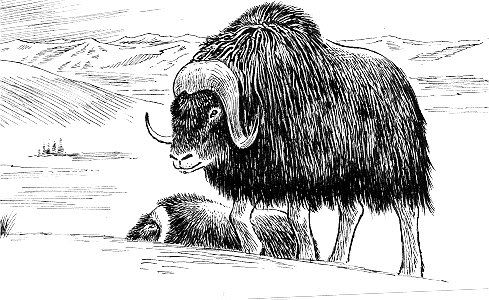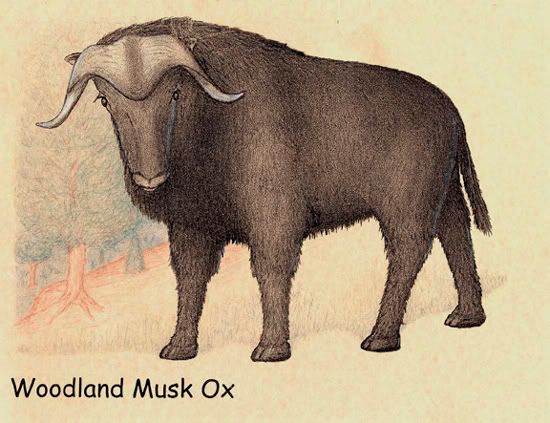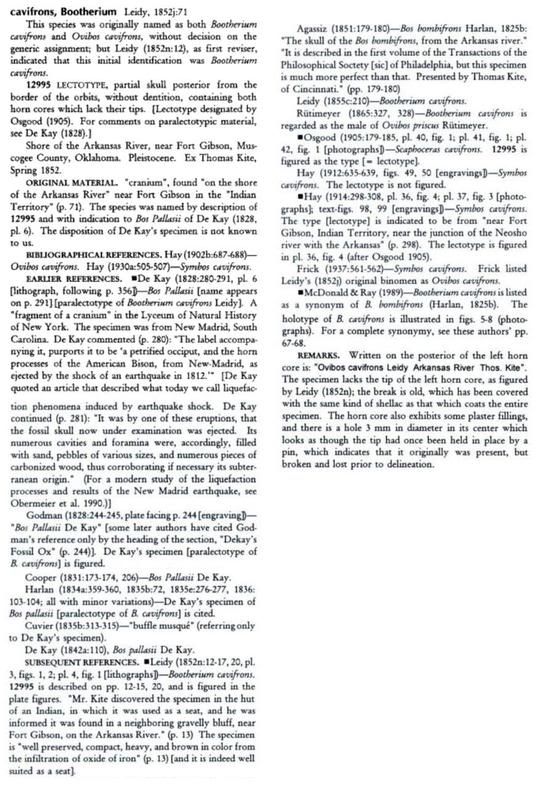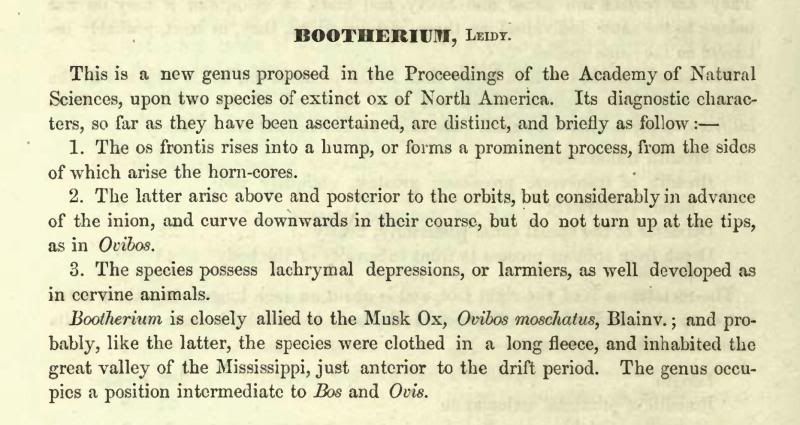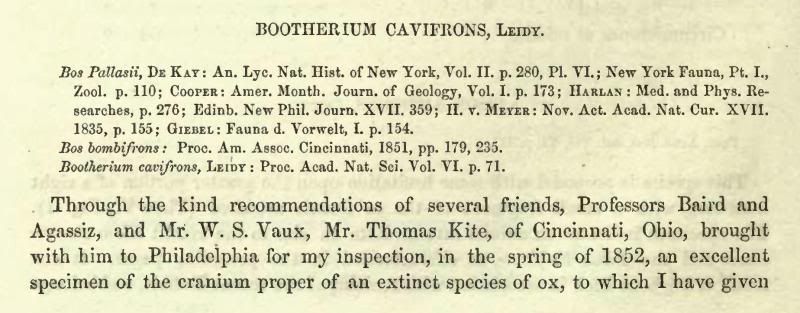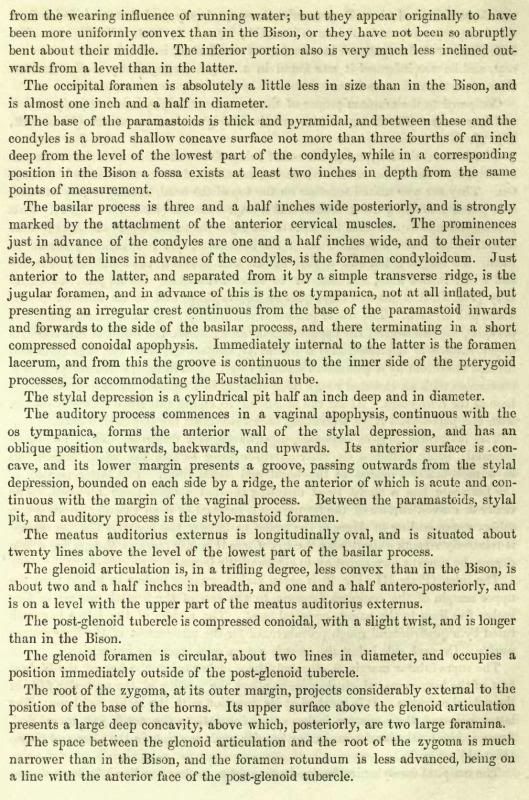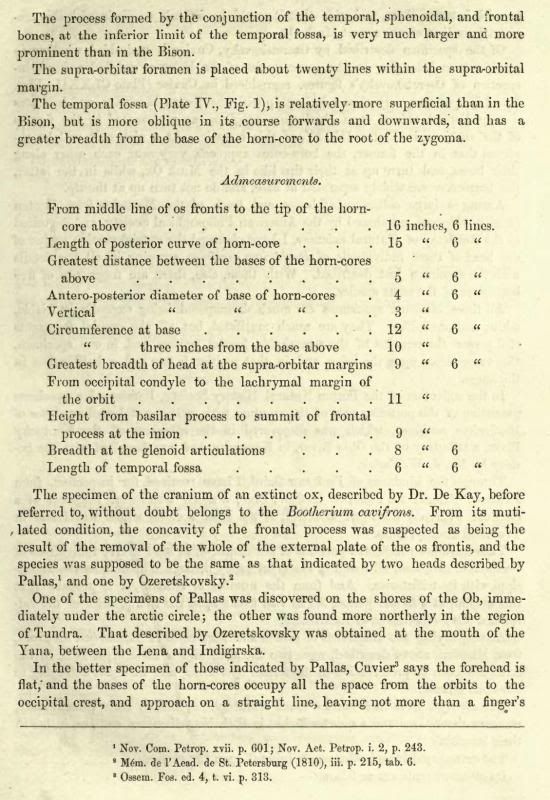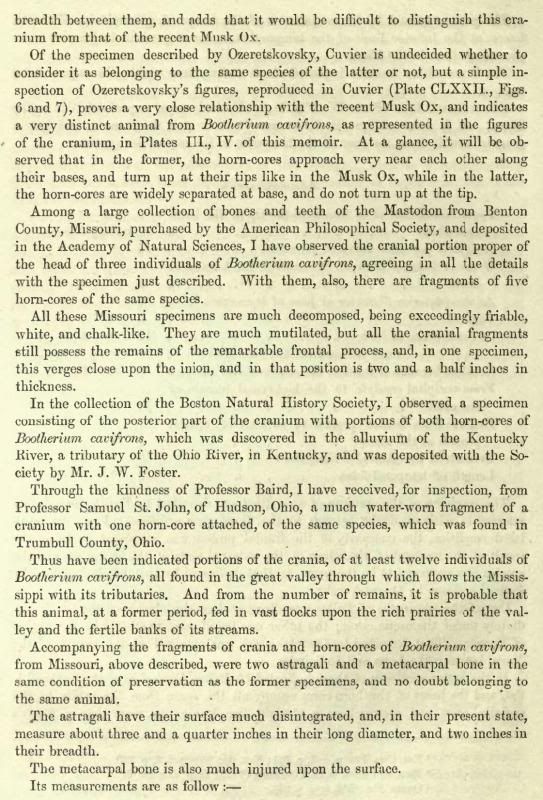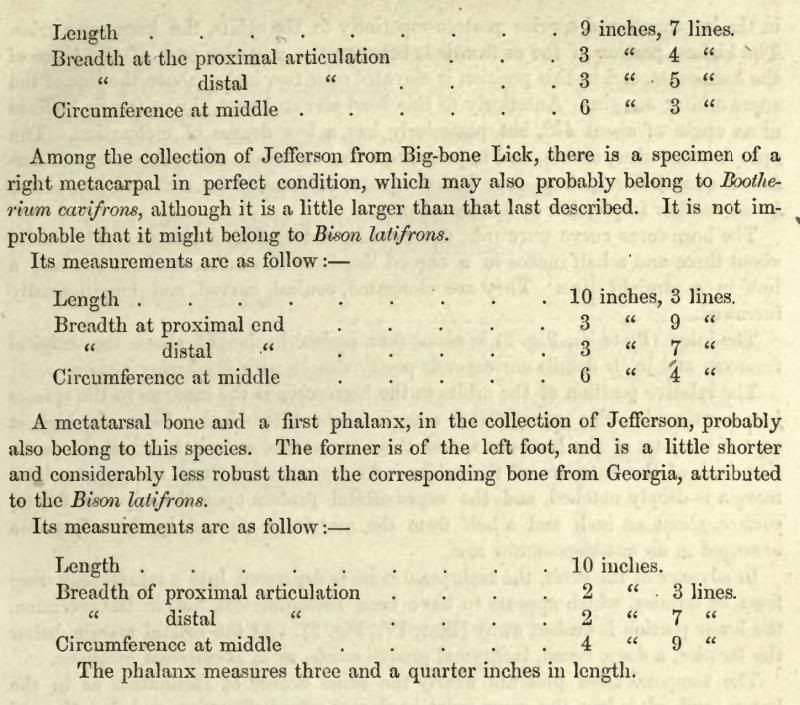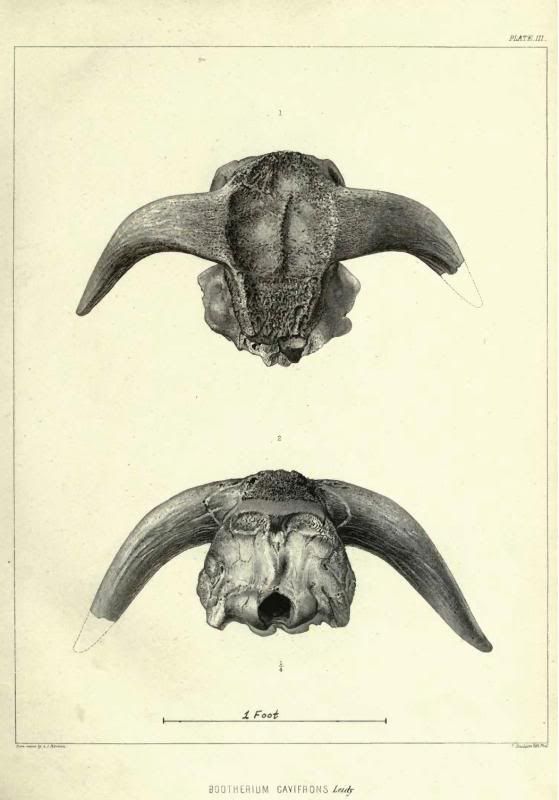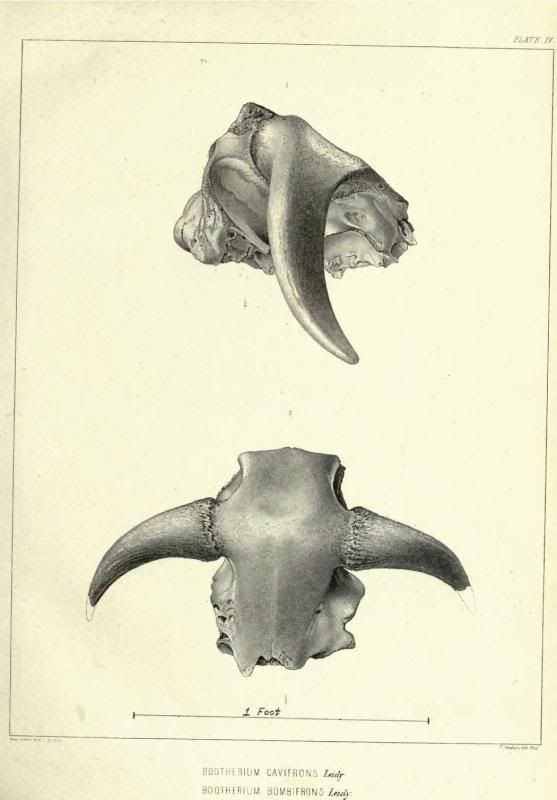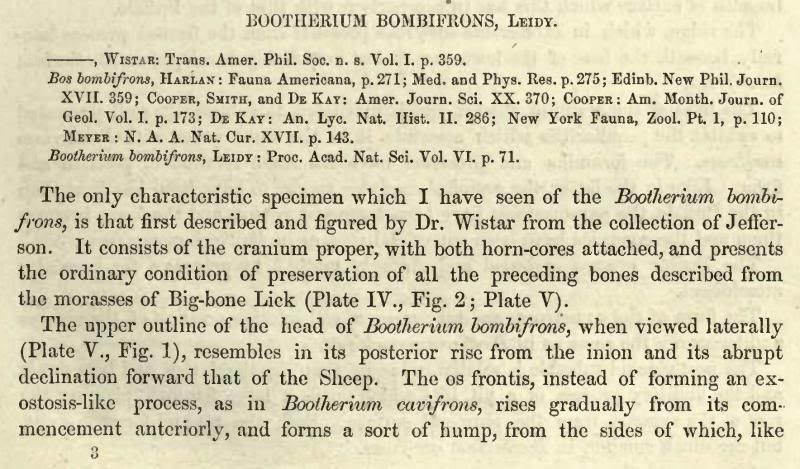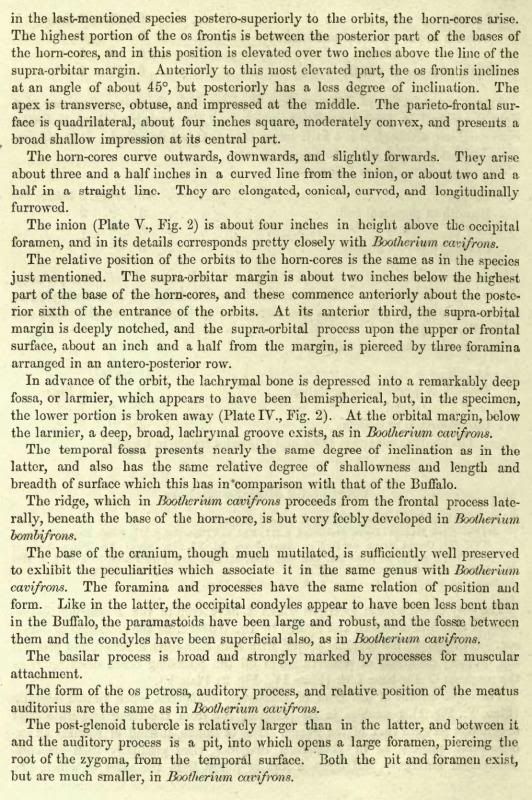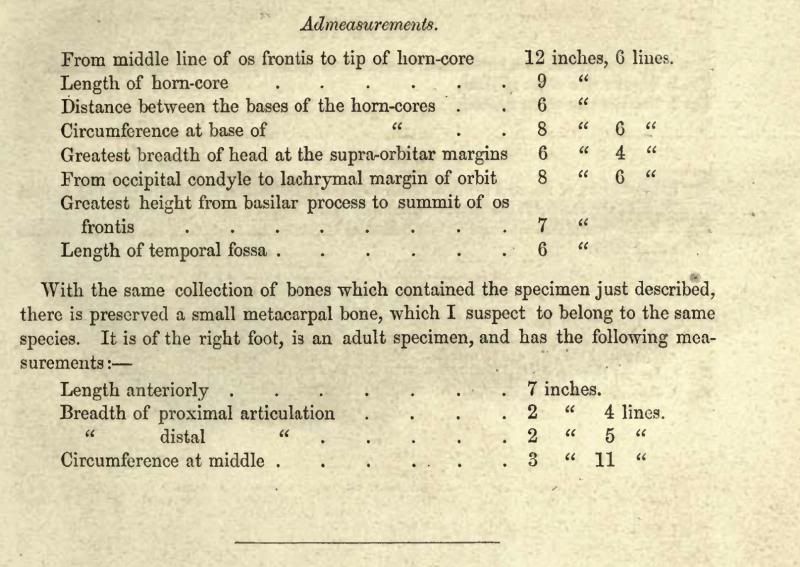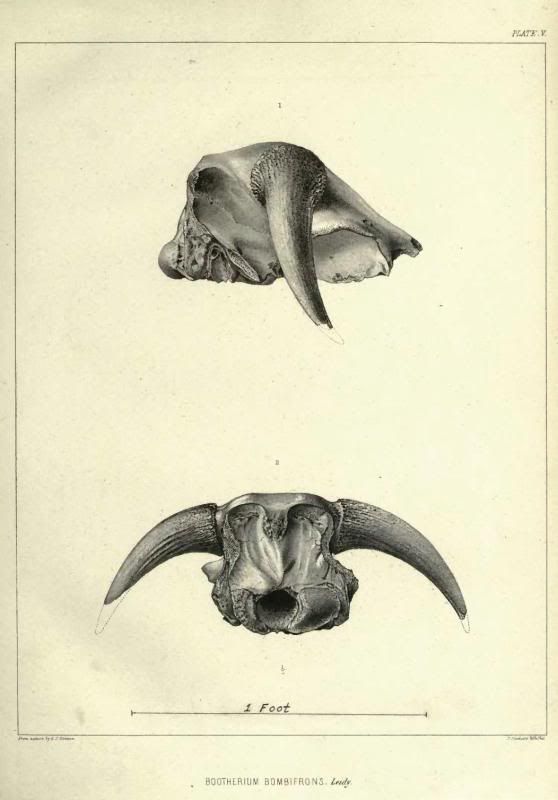Post by another specialist on May 23, 2008 19:44:26 GMT
Helmeted Muskox
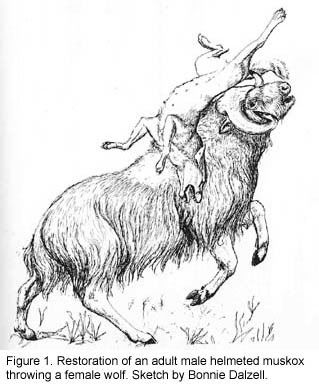
The helmeted muskox (Bootherium bombifrons) was one of five different kinds of muskoxen (Tribe Ovibovini) that lived in North America during the Pleistocene (about 2 million to 10,000 years ago). It was confined to North America, and according to the number of fossils preserved, was the dominant and most widespread muskox on this continent.
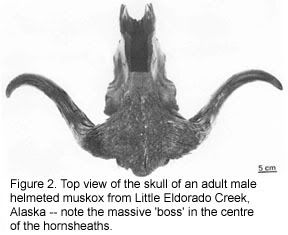
Helmeted muskox males (Figure 1) were taller and slenderer than those of the living tundra muskox [Ovibos moschatus – the sole Holocene (about 10,000 years ago to the present) survivor]. Further, a comparison of the shapes of young female helmeted and tundra muskoxen, indicates that the former were not only taller but had fore and hind legs closer together. Bootherium males had longer, deeper skulls supporting higher, more flaring horns with massive fused bases (Figure 2) – thus the term 'helmeted'. Another character of the male skulls was a large, roughly-pitted basin between the horncores – rather than having a 'part' between the horncores, as in tundra muskox males. Hair found with a partial male skeleton from Little Eldorado Creek near Fairbanks, Alaska indicates that the helmeted muskox had a dark brown coat like the tundra muskox, but that its hair was shorter and finer. Another hint that Bootherium had a thinner coat than Ovibos and could adapt to warmer habitats is that its orbits (bone around the eye sockets) protrude less. For example, the famous Arctic explorer, Sir Edward Parry, Royal Navy (1821), among others, thought that the projection of the eye sockets in Ovibos served the purpose of carrying the eye clear of the hairy coat – thus indicating the degree of insulation.
Bootherium bombifrons was initially described in 1825. A field party sent out by Thomas Jefferson found a partial skull and other bones at Big Bone Lick, Kentucky when the living tundra muskox was hardly known to science. About 30 years later another extinct North American muskox, Symbos cavifrons was described. Since remains of Bootherium and Symbos often occurred together in the same localities and strata, and physically resembled (Symbos being considered the male of Bootherium) males and females of extant tundra muskoxen, both are now called helmeted muskoxen (Bootherium bombifrons). The early taxonomic confusion arose mainly from sexual dimorphism (the great difference in the appearance of males and females).
Perhaps helmeted muskoxen evolved in broad, intermontane valleys in 'Beringia' (unglaciated country between northeastern Siberia and land just east of the Mackenzie Delta), dispersing to lower plains during the coldest periods of the Illinoian (200,000 or more years ago) and Wisconsinan (about 90,000 to 10,000 years ago) glaciations. Their ancestors probably looked like the Holarctic (circumpolar parts of Eurasia and North America) Middle Pleistocene muskox Praeovibos – a type that may also have given rise to the living tundra muskox.
The earliest records of Bootherium seem to be Illinoian in both northwestern North America (e.g. from Cripple Creek Sump silt in central Alaska) and what is now the United States (e.g. deposits in Nebraska and Arkansas). Specimens are known from last (Sangamonian – about 130,000 years ago) interglacial deposits in Saskatchewan (e.g. Saskatoon and probably Fort Qu'Appelle). In Alaska and Yukon, radiocarbon dates on bone from this species run between greater than 43,000 and about 17,000 years ago, and most North American specimens are known to, or considered to date from Late Wisconsinan time. The latest radiocarbon-dated helmeted muskox records are from St. Mary's Reservoir near Cardston, southern Alberta (10,980 ± 90 years ago) and near Scotts, Michigan (11,100 ± 160 years ago).
Bootherium was widespread, occurring from Alaska and northern Yukon (Herschel Island) to southern Texas and from the Pacific coast (e.g. Saanich, Vancouver Island, British Columbia) to the Atlantic Continental Shelf 40 miles southeast of Atlantic City, New Jersey. In Canada, Bootherium bombifrons is known from: Yukon (Dawson City area; Old Crow Basin; Sixtymile; Herschel Island), British Columbia (Dease Lake; Saanich Peninsula, Vancouver Island), Alberta (Fort Saskatchewan; St. Mary Reservoir), and Saskatchewan (Saskatoon area; Fort Qu'Appelle).
Evidence concerning the habitat of that species is equivocal – various researchers concluded that Bootherium was: (1) a woodland form that foraged along lake and forest margins, and was probably a member of the fauna including other large, extinct mammals, such as American mastodons (Mammut americanum), Scott's moose (Alces scotti = Cervalces scotti) and giant beavers (Castoroides ohioensis); (2) a woodland or steppe form; (3) a prairie rather than tundra species; and (4) adapted to alpine grasslands. Probably, all of these habitats were occupied at various times and places by Bootherium, and it is best to consider it as highly adaptable. It is interesting to note that helmeted muskox range in the conterminous United States and Alaska coincides approximately with former loess-steppe regions (grasslands developed on windblown dust from glacial margins). A specimen from Dease Lake in north-central British Columbia suggests that these muskoxen could adapt to mountainous terrain. Fossils from Saanich Peninsula, Vancouver Island, and the Atlantic Continental Shelf indicate that Bootherium herds were able to adapt to flattish terrain near sea level. Analysis of dung pellets associated with the Little Eldorado Creek, Alaska specimen suggests that this large male had fed on grasses and sedges during the winter.
Similarities in horn shape between tundra and helmeted muskoxen suggest similarities in social behaviour and predator defense. Adult males undoubtedly used their massive, fused hornbases ('bosses') in head-on clashes during the autumn mating period – part of the process of establishing herd dominance. The relatively long, curved horns with sharp, upcurved tips served both sexes as formidable weapons against predators such as wolves (Canis lupus … e.g. Figure 1). Evidently helmeted muskoxen were not widely hunted by people (Homo sapiens), although stone flakes and flake tools were recovered in association with Bootherium and horse (Equus conversidens) bones at the late-glacial St. Mary Reservoir site in southern Alberta. Indeed, dried traces of horse and bovid – probably Bison or Bootherium blood (protein residue) were found on three Paleoindian points from this site. In addition, part of a lower hind leg bone (tibia) from Saltville, Virginia that yielded a radiocarbon date of 14,510 ± 80 years ago 'appears to have been modified by humans'.
Nevertheless, despite its apparently broad environmental adaptation, rapidly changing environment and competition with tundra muskoxen in the northern parts of its range, and with medium-horned bison [e.g. western bison (Bison bison occidentalis) and ancient bison (Bison bison antiquus)] were probably more important in the extinction of helmeted muskoxen than human hunting. This species died out toward the close of the last glaciation about 11,000 years ago, like mammoths and American mastodons.
www.beringia.com/02/02maina13.html

The helmeted muskox (Bootherium bombifrons) was one of five different kinds of muskoxen (Tribe Ovibovini) that lived in North America during the Pleistocene (about 2 million to 10,000 years ago). It was confined to North America, and according to the number of fossils preserved, was the dominant and most widespread muskox on this continent.

Helmeted muskox males (Figure 1) were taller and slenderer than those of the living tundra muskox [Ovibos moschatus – the sole Holocene (about 10,000 years ago to the present) survivor]. Further, a comparison of the shapes of young female helmeted and tundra muskoxen, indicates that the former were not only taller but had fore and hind legs closer together. Bootherium males had longer, deeper skulls supporting higher, more flaring horns with massive fused bases (Figure 2) – thus the term 'helmeted'. Another character of the male skulls was a large, roughly-pitted basin between the horncores – rather than having a 'part' between the horncores, as in tundra muskox males. Hair found with a partial male skeleton from Little Eldorado Creek near Fairbanks, Alaska indicates that the helmeted muskox had a dark brown coat like the tundra muskox, but that its hair was shorter and finer. Another hint that Bootherium had a thinner coat than Ovibos and could adapt to warmer habitats is that its orbits (bone around the eye sockets) protrude less. For example, the famous Arctic explorer, Sir Edward Parry, Royal Navy (1821), among others, thought that the projection of the eye sockets in Ovibos served the purpose of carrying the eye clear of the hairy coat – thus indicating the degree of insulation.
Bootherium bombifrons was initially described in 1825. A field party sent out by Thomas Jefferson found a partial skull and other bones at Big Bone Lick, Kentucky when the living tundra muskox was hardly known to science. About 30 years later another extinct North American muskox, Symbos cavifrons was described. Since remains of Bootherium and Symbos often occurred together in the same localities and strata, and physically resembled (Symbos being considered the male of Bootherium) males and females of extant tundra muskoxen, both are now called helmeted muskoxen (Bootherium bombifrons). The early taxonomic confusion arose mainly from sexual dimorphism (the great difference in the appearance of males and females).
Perhaps helmeted muskoxen evolved in broad, intermontane valleys in 'Beringia' (unglaciated country between northeastern Siberia and land just east of the Mackenzie Delta), dispersing to lower plains during the coldest periods of the Illinoian (200,000 or more years ago) and Wisconsinan (about 90,000 to 10,000 years ago) glaciations. Their ancestors probably looked like the Holarctic (circumpolar parts of Eurasia and North America) Middle Pleistocene muskox Praeovibos – a type that may also have given rise to the living tundra muskox.
The earliest records of Bootherium seem to be Illinoian in both northwestern North America (e.g. from Cripple Creek Sump silt in central Alaska) and what is now the United States (e.g. deposits in Nebraska and Arkansas). Specimens are known from last (Sangamonian – about 130,000 years ago) interglacial deposits in Saskatchewan (e.g. Saskatoon and probably Fort Qu'Appelle). In Alaska and Yukon, radiocarbon dates on bone from this species run between greater than 43,000 and about 17,000 years ago, and most North American specimens are known to, or considered to date from Late Wisconsinan time. The latest radiocarbon-dated helmeted muskox records are from St. Mary's Reservoir near Cardston, southern Alberta (10,980 ± 90 years ago) and near Scotts, Michigan (11,100 ± 160 years ago).
Bootherium was widespread, occurring from Alaska and northern Yukon (Herschel Island) to southern Texas and from the Pacific coast (e.g. Saanich, Vancouver Island, British Columbia) to the Atlantic Continental Shelf 40 miles southeast of Atlantic City, New Jersey. In Canada, Bootherium bombifrons is known from: Yukon (Dawson City area; Old Crow Basin; Sixtymile; Herschel Island), British Columbia (Dease Lake; Saanich Peninsula, Vancouver Island), Alberta (Fort Saskatchewan; St. Mary Reservoir), and Saskatchewan (Saskatoon area; Fort Qu'Appelle).
Evidence concerning the habitat of that species is equivocal – various researchers concluded that Bootherium was: (1) a woodland form that foraged along lake and forest margins, and was probably a member of the fauna including other large, extinct mammals, such as American mastodons (Mammut americanum), Scott's moose (Alces scotti = Cervalces scotti) and giant beavers (Castoroides ohioensis); (2) a woodland or steppe form; (3) a prairie rather than tundra species; and (4) adapted to alpine grasslands. Probably, all of these habitats were occupied at various times and places by Bootherium, and it is best to consider it as highly adaptable. It is interesting to note that helmeted muskox range in the conterminous United States and Alaska coincides approximately with former loess-steppe regions (grasslands developed on windblown dust from glacial margins). A specimen from Dease Lake in north-central British Columbia suggests that these muskoxen could adapt to mountainous terrain. Fossils from Saanich Peninsula, Vancouver Island, and the Atlantic Continental Shelf indicate that Bootherium herds were able to adapt to flattish terrain near sea level. Analysis of dung pellets associated with the Little Eldorado Creek, Alaska specimen suggests that this large male had fed on grasses and sedges during the winter.
Similarities in horn shape between tundra and helmeted muskoxen suggest similarities in social behaviour and predator defense. Adult males undoubtedly used their massive, fused hornbases ('bosses') in head-on clashes during the autumn mating period – part of the process of establishing herd dominance. The relatively long, curved horns with sharp, upcurved tips served both sexes as formidable weapons against predators such as wolves (Canis lupus … e.g. Figure 1). Evidently helmeted muskoxen were not widely hunted by people (Homo sapiens), although stone flakes and flake tools were recovered in association with Bootherium and horse (Equus conversidens) bones at the late-glacial St. Mary Reservoir site in southern Alberta. Indeed, dried traces of horse and bovid – probably Bison or Bootherium blood (protein residue) were found on three Paleoindian points from this site. In addition, part of a lower hind leg bone (tibia) from Saltville, Virginia that yielded a radiocarbon date of 14,510 ± 80 years ago 'appears to have been modified by humans'.
Nevertheless, despite its apparently broad environmental adaptation, rapidly changing environment and competition with tundra muskoxen in the northern parts of its range, and with medium-horned bison [e.g. western bison (Bison bison occidentalis) and ancient bison (Bison bison antiquus)] were probably more important in the extinction of helmeted muskoxen than human hunting. This species died out toward the close of the last glaciation about 11,000 years ago, like mammoths and American mastodons.
www.beringia.com/02/02maina13.html


